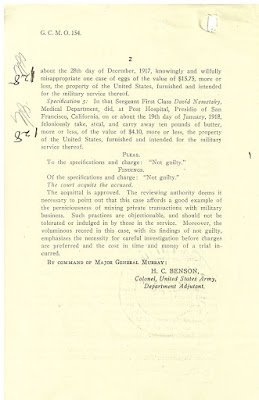In 1940, Grandpa Jim was living at 405 Jackson Street in Rawlins, Wyoming, with his wife, Alice, and their two sons, Robert (10) and Alfred (8). Jim & Alice married in November of 1929 in Fort Collins, Colorado, and lived at the Windmill Ranch west of Laramie until 1936, when they moved to Rawlins. My great-grandma was born and raised in Carbon County, Wyoming, (Hanna and Saratoga) and a number of her siblings lived in and around Rawlins. According to the 1940 Census, Jim was unemployed and had only worked the equivalent of 26 weeks in 1939. When I found the 1940 Census, I wasn’t sure of the reason for him being out of work. This next post sheds light on his situation during this time.
Back in 1924, the hospitalization of veterans for disability and treatment regardless of origin of the disability was first authorized. A letter has been sent to Jim on December 27, 1924, informing him that he may be eligible for these services. However, this letter was sent to him at Buena Vista, Colorado, when by this time he had left Colorado and was living in Wyoming. This letter also contains his claim number, something that he likely wasn’t aware of. By 1940, he was in need of medical assistance, and applied for hospital treatment on March 29, 1940 (the application wasn’t included in the Claims File I received). He was admitted to the VA Hospital in Cheyenne, Wyoming on April 8, 1940, where he was diagnosed with tonsilitis and neuritis (peripheral nerve inflammation).
He also filled out a statement giving information on his family, giving his marital status and the age of his youngest child (Alfred, who was then 7 years old). This form was completed in order to facilitate the claims process and to have a claims number assigned. However, the Veteran’s Administration was able to locate his claims file, which had sat dormant since 1921 at the Central Office in Washington, D.C. The Claims file was sent to Cheyenne, and his application and record of hospitalization were added to his file.
During April and May of 1940, Grandpa Jim received medical treatment at the VA Hospital in Cheyenne. He was treated for myositis (muscle inflammation), tonsilitis (his tonsils were removed) and teeth extraction. The medical record notes that he had numerous teeth missing (15 total by the time he was discharged from the hospital). He spent a total of 49 days in the VA Hospital and was discharged on May 27, 1940.
Although this hospitalization would have helped his health, he was still struggling physically. In April of 1941, my great-grandma wrote a letter to the VA inquiring about assistance and the possibility of obtaining a pension. They responded by sending an application for disability/pension benefits for Grandpa Jim to complete. It doesn’t appear that this application was filled out as there was no copy of the application in the copy of the Claims File I received.
When my great-grandma wrote the letter to the VA in April of 1941, they had moved to 633 West Davis Street, on the south side of Rawlins. They had begun to build a home on this lot of land by this time. I remember my grandpa telling me that they got the lumber from an abandoned mill not far from town. By this time, World War II was in full swing and materials of all kinds were in short supply. According to his WWII Draft Card in 1942, Grandpa Jim had found work with Carbon County. The WWII Draft card gives his physical description: 6 feet tall and 135 pounds with brown hair and grey eyes. I suppose his physical ailments he had suffered give context to his very thin frame. A couple of years later, he was working with the Union Pacific Railroad as a car inspector. From a yearly pay stub I have, he was making about $3,600 per year with the railroad, which is nearly $45,000 per year today. He used the money that he earned into building their home.
Below are a few pictures of them
at the home on Davis Street. The first two are from 1942 and are of my great-grandma and my grandpa. The third is Grandpa Jim (second from right) outside the home in 1947.
Grandpa Jim passed away in December of 1949 at the age of 55. My next post will go over the death and funeral benefits that my great-grandma received following his death.





















